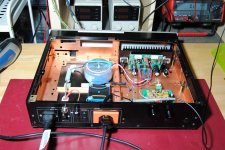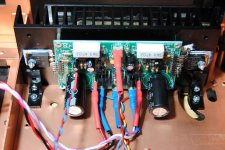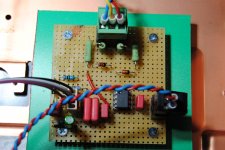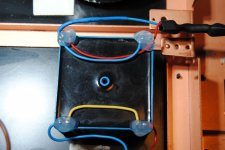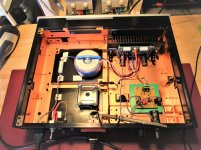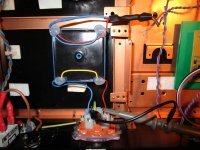You might go through the thread for examples of non working prototypes. I always used resistors or ntc.
I am using the cheap Chinese relays, so I can bypass the resistor, so I do not have a space heater with the big motors I am using.
Enjoy the ride
Tom
PS Ralph posted he got away with the slow ramp up of the SG4. Might check the post I think that was on the SG4 thread.
I am using the cheap Chinese relays, so I can bypass the resistor, so I do not have a space heater with the big motors I am using.
Enjoy the ride
Tom
PS Ralph posted he got away with the slow ramp up of the SG4. Might check the post I think that was on the SG4 thread.
OK, so where can one find the 5D-9 NTC? Mouser, Digikey, etc?? While waiting for SG-4 parts, I would like to try the XR2206/LM3886 as I have these parts and transformers and stock VPI/Hurst motor.
EBay is your friend. Good news your motor does not draw much current. I have been lazy and have not hooked up my SG4 to the unit I have been using.
Tom
Tom
Hi all, can you guys tell me what is your max current capability on that final setup for you big motors. I'm thinking to make that concept working as power plant for my sensitive MC phono amp. If I can get 1A capability with that concept, then my JFET phono will be very happy with this clean AC. I need about 350mA, but nice to have some margin.
Sent from my iPhone using Tapatalk
Sent from my iPhone using Tapatalk
Last edited:
At some point your MC preamp will need DC. A lead battery with lets say a 1 uF shunt capacitor starts to be perfection. I built this for a friend using a virtually sillent charger ( noise at - 125 dB related to 12 V ). I could have gone lower in noise if it weren't a chager. This allows audio use when the charging gets forgotten.
The problem a regenerator power supply has ( as I think you want ) is you still have the powering diodes in the AC to DC side of your device to cause noise. These might be improved by using lets say soft recovery diodes. If a lead ( or whatever ) accumulator to give it it's correct name there is no diode noise. Lead types are said to be slow. The 1 uF is the cure for that.
The problem a regenerator power supply has ( as I think you want ) is you still have the powering diodes in the AC to DC side of your device to cause noise. These might be improved by using lets say soft recovery diodes. If a lead ( or whatever ) accumulator to give it it's correct name there is no diode noise. Lead types are said to be slow. The 1 uF is the cure for that.
Battery is not applicable in our phono. My MC phono uses 36VDC and we deliver 50V Raw DC to its PCB with integrated shut that maintains stable and clean DC. Raw Power supply is in separated box and I use DC blocked prior R-Core (Rod Elliot), and K-Multiplier (kind of C-Multiplier from Keantoken) is to min V ripple at the end. Snubbers are used to depress Diodes ringing (Quasimodo rig tester) and I use Ultra-fast (30ns) with soft recovery Diodes . My concern is frequency (60Hz) instability with high frequency noise added and house V (120VAC) fluctuations. My V fluctuates from 114V to 123V during day time. RFI is also concerns me. Second, and based on my limited expense with several RIAAs, battery powered Phono has very compressed sound compare to nice designed AC->DC PSU.
Sent from my iPhone using Tapatalk
Sent from my iPhone using Tapatalk
A regenerator seems worth a try. Although a battery powered PSU should be fine I have heard some that were not. I suspect that was bad design and not the batteries.
I think from what you say you very nearly have the same result as a regenerator by keeping the boxes sepparate and the DC mains component blocking. If as in the link try more uF than Rod.
Mains DC and Transformers
I think from what you say you very nearly have the same result as a regenerator by keeping the boxes sepparate and the DC mains component blocking. If as in the link try more uF than Rod.
Mains DC and Transformers
I tested one (30kg weight) unit made by one of very reputable company (at least they present themselves in that way and charge about $6K for that phono). It took two guys to bring it in and I waited about 8 hours to charge internal battery and after all, my known record sound came with no any impression at all and I was very disappointed. All my component setup was very nice and universally must match any dissent phono. BTW, I use Wilsom Benesch Cirlce One TT with original Arm and Ply cart.
So, back to my question... Yes, I would like to keep the setup as for regular wall AC receptacle, but to use power plant to make artificial 120VAC 60Hz with max precision that I can achieve with our parts.
Big question is if it is enough current to support my phono.
Sent from my iPhone using Tapatalk
So, back to my question... Yes, I would like to keep the setup as for regular wall AC receptacle, but to use power plant to make artificial 120VAC 60Hz with max precision that I can achieve with our parts.
Big question is if it is enough current to support my phono.
Sent from my iPhone using Tapatalk
Last edited:
Usually if you say the whole set up is at best 50% efficient and you need perhaps 100 watts, you then have 100 watts to throw away. You could get 63 % if using switchmode PSU. I suspect that wouldn't be what you would want ( it can work if a spectrum analyser can check no RFi ). Some of the lost 13% is regulating the output voltage. If we take a 0.5 degrees per watt heat sink that's 50 C. Taking ambient to be 30C that is too high. This suggests two 0.5 type ( usually cheaper than one 0.25 ). You can go for forced air cooled and keep it in another room.
Even the very cheap power meters from Walmart etc say the VA of loads. I find most are good enough. If using a chip power amp look back to my FET soft start in this thread. You will need something like that as the chip amps are marginal for this use. A simple T03 amp design would suit well ( 2N3055 or better ). Alas the Velleman kit is discontinued as that was close to what's required. Rod Elliot might have a kit.
You can filter a small mains transformer output to get a very pure sinewave. There are advanatages as no beat frequency which simplifies grounding. Ti Filter Pro is a good design tool. One can use Chebishev as it is a fixed frequency relative to the next cycle
Even the very cheap power meters from Walmart etc say the VA of loads. I find most are good enough. If using a chip power amp look back to my FET soft start in this thread. You will need something like that as the chip amps are marginal for this use. A simple T03 amp design would suit well ( 2N3055 or better ). Alas the Velleman kit is discontinued as that was close to what's required. Rod Elliot might have a kit.
You can filter a small mains transformer output to get a very pure sinewave. There are advanatages as no beat frequency which simplifies grounding. Ti Filter Pro is a good design tool. One can use Chebishev as it is a fixed frequency relative to the next cycle
So, I do need 200W amp and 5A switched PSU to feed it. I have Lambda switched with 24VDC and 6.3A. I think that one will be sufficient one. I see some 2N3055 PCBs on eBay but all of them is 100W. I use TPA3116 for me TT with Hurst, but I assume it will be not power enough to feed Phono. I'll check Elliot for kit. Please send me a link if you found it already. Thank you a lot for advises.
Sent from my iPhone using Tapatalk
Sent from my iPhone using Tapatalk
The problem I see is 200 watts continuous relates to a 600 watt amplifier for music ( or worse ). This one is worth a look.
http://www.diyaudio.com/forums/solid-state/235892-1000w-simple-pa-amplifier.html
http://www.diyaudio.com/forums/solid-state/235892-1000w-simple-pa-amplifier.html
Nice one, but it will be endless project. I need at least Bare PCB in order to start something like that. Any advice for kit or PCB?
Sent from my iPhone using Tapatalk
Sent from my iPhone using Tapatalk
I think it will be difficult. At work we used a big Amcron amp for similar. I imagine one of the modern theatre amps could work. Now everyone is going class D the big units ( Class H etc ) are sold cheaply.
Hi Tom,
Glad to hear everything works.
I did a quick search and in a second I found this low cost scope.
USB oscilloscoop en Logic Analyzer - Free Shipping - DealExtreme
I'm sure when you put some more effort in searching, you will find comparable offers,
Having two channels makes checking phases a whimp.
Hans
Thanks a ton Hans. I've been reading through this thread slowly but surely, and saw this post. Went to take a look and lo and behold! They have a 1/3 off special offer on the go. Hesitation does not appear in my vocabulary when this kind of deal is staring me in the face. Paid for it and have a tracking number. Best deal in SA currently is twice the normal price at DealExtreme. Kevin
Last edited:
I used well discussed here parts and finished my TT motor controller. Thank you all.


Sent from my iPhone using Tapatalk


Sent from my iPhone using Tapatalk
I have an Ariston RD80 that uses a premotec 31813 synchronous motor.
As I live in Europe, the motor is wired for 220VAC operation.
As the motor is built for 110VAC operation, I have one 10kohm in series and a 0.22uF capacitor to create 90° phase shift on the second winding.
I followed Linn PSU evolutions and some years ago I built a rig with a step down transformer so to feed only 110VAC to the motor.
Noise was considerably reduced but torque was much lower so I got more microdetail and a overall more relaxed sonic presentation but lost some of the "attack" needed to recreate a credible soundstage.
I have been using this TT for more than 40 years now and grew used to it's sonic image but I always felt it run too fast so I searched for a way to control it's speed so to reach the perfect pitch.
After reading this thread I decided to try a generator feeding a power amp terminated with a transformer.
Initially I bought one XR2206 rig that did not produce good sinusoids and also tried one 555 build with even worst results.
So I decided to build a wien bridge with a fet instead of the usual lamp used to control amplitude.
I finally decided to use a very large Vp fet as it is better behaving as a voltage regulated resistor.
Many experiments where needed before I could find a good solution but now it works as intended.
I am feeding the signal through a pot into a 100w power amp and placed a 12VAC to 220VAC transformer in the output.
Now I can not hear or feel any vibrations coming from the premotec, the pitch is perfect as I can set speed accurately and I can control the torque using the "volume" pot installed at the power amp input.
Next action will be to build a phase shifter, add a second power amp and see if it improves the matters even more.
As I live in Europe, the motor is wired for 220VAC operation.
As the motor is built for 110VAC operation, I have one 10kohm in series and a 0.22uF capacitor to create 90° phase shift on the second winding.
I followed Linn PSU evolutions and some years ago I built a rig with a step down transformer so to feed only 110VAC to the motor.
Noise was considerably reduced but torque was much lower so I got more microdetail and a overall more relaxed sonic presentation but lost some of the "attack" needed to recreate a credible soundstage.
I have been using this TT for more than 40 years now and grew used to it's sonic image but I always felt it run too fast so I searched for a way to control it's speed so to reach the perfect pitch.
After reading this thread I decided to try a generator feeding a power amp terminated with a transformer.
Initially I bought one XR2206 rig that did not produce good sinusoids and also tried one 555 build with even worst results.
So I decided to build a wien bridge with a fet instead of the usual lamp used to control amplitude.
I finally decided to use a very large Vp fet as it is better behaving as a voltage regulated resistor.
Many experiments where needed before I could find a good solution but now it works as intended.
I am feeding the signal through a pot into a 100w power amp and placed a 12VAC to 220VAC transformer in the output.
Now I can not hear or feel any vibrations coming from the premotec, the pitch is perfect as I can set speed accurately and I can control the torque using the "volume" pot installed at the power amp input.
Next action will be to build a phase shifter, add a second power amp and see if it improves the matters even more.
Attachments
And how does it sound ?
It is like I have a new TT..... more silent, much more detailed, the sound image is more stable and larger and the bass is present with good pitch and attack.
It is like I have a new TT..... more silent, much more detailed, the sound image is more stable and larger and the bass is present with good pitch and attack.
I had made the same observations by listening tests on Linn's LP12 by using the motor control from Dr. Fuß as replacement for Linn's LINGO - go to
Linn Lingo vs. Dr. Fuß or Square-Wave vs. Sine Wave Oscillator for Motor Control
Homebrew Motor Control Linn LP12 - Circuit Description wanted for Sine Wave Osc.
Erfahrung mit Dr.Fuss Netzteil im Linn LP12 - Plattenspieler - Analogue Audio Association
Linn Lingo vs. Dr. Fuß or Square-Wave vs. Sine Wave Oscillator for Motor Control
Homebrew Motor Control Linn LP12 - Circuit Description wanted for Sine Wave Osc.
Erfahrung mit Dr.Fuss Netzteil im Linn LP12 - Plattenspieler - Analogue Audio Association
- Home
- Source & Line
- Analogue Source
- Optimally driving a (VPI) synchronous turntable motor
